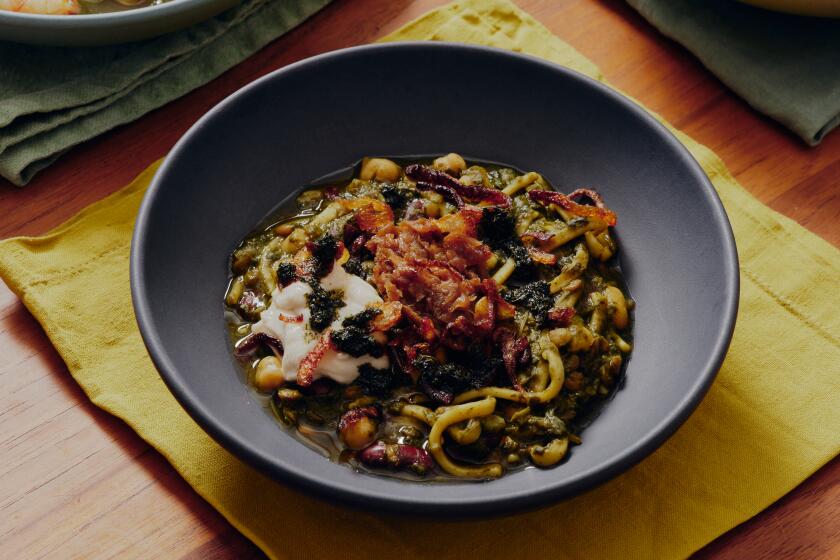Lentils With Spinach
- Share via
A few years ago a BBC radio program in England re-created the meal that Robert Clive, a trader and part-time British soldier, might have eaten following his victorious battle against the king of Bengal in 1757. According to an Indian restaurateur, Clive almost surely feasted like an Indian king, consuming dishes such as biryani (chunks of goat meat mixed with saffron-streaked rice), chicken do-piyaza (marinated chicken cooked with a surfeit of onions) and malai chingri (prawns in coconut cream sauce).
It’s also likely, although the restaurateur didn’t say so, that Clive savored the shahi gilaawat ka kebab, an exquisite dumpling once made only for Indian nobles from no less than 160 ingredients.
Such rich, royal food is common in India today and widely available around the world. The trouble is that few lovers of Indian food are blessed with the constitution of a typical 18th century soldier. Those who eat heartily at the average restaurant serving Mughlai cuisine in Bombay, London, Tokyo or Los Angeles are likely to find that they cannot properly digest their meals without a long nap, especially during the hot summer months.
But not all Indian food is oily, rich and spicy. India has numerous regional cuisines, and there are huge differences in their approach to cooking. At the same time, because of the country’s relatively undeveloped restaurant culture, nutritious, low-fat cooking is generally not practiced outside Indian homes. Not surprisingly, many Westerners wish Indian cuisine were lighter.
There’s good news for those who share that lament. Low-fat cooking is catching on in Indian restaurants. Led by a handful of Indian epicures, restaurants catering largely to the upper-middle class are offering food that’s wholesome and light. Even a look at the Internet confirms this trend. Numerous Indian food Web sites are devoted to “fat-free” cooking--and even vegan food. One Web site offers recipes under the headings “The Looking Good Diet” and “The Forever Young Diet”--topics that nobody would have associated with Indian food just a few years ago.
The first Indian restaurant to cater to the modern demand for low-fat cooking is the Kandahar, named after the ancient Afghan city that has been much in the news lately. Located in the posh Oberoi Hotel in Bombay, India’s premier city for restaurants, the Kandahar lends a unique subtlety to the typically coarse cuisine of the so-called North-Western Frontier Province.
The restaurant serves gravies--or “curries,” as the British like to call them--that are lighter, thinner and gentler than the traditional sort, thanks to a judicious use of double cream and pastes of cashew and almond. In business circles, the Kandahar is reputed to be one of the few restaurants in the country where executives can have lunch and actually get back to work.
The man behind Kandahar’s success is Jiggs Kalra, a noted Indian gastronome, columnist and food consultant. Kalra likes to call himself a “creator” of dishes rather than a cook, which means that he never wears an apron or wields a ladle--not even at international food festivals, where to be seen in chef’s attire is an honor.
Kalra is widely believed to have reinvented traditional northern Indian cuisine. He has brought an authenticity to restaurant fare that was widely lacking, while also creating menus that satisfy modern sensibilities. For instance, he is one of the first Indians to introduce sequential dining--the Western practice of serving a meal in courses. Indian restaurateurs once considered sequential dining impossible to achieve for the simple reason that Indian cuisine, with its emphasis on a medley of curries, does not lend itself naturally to courses. Kalra got around the problem partly by fusing rustic Punjabi dishes with sophisticated Western ones.
Last year, not long after the Kandahar unleashed India’s low-fat cooking revolution, the Mandarin Oriental group opened a 100-acre luxury spa in the Himalayas. Ananda--the name means “bliss” in Hindi--is the first spa of its kind in India. It has a single restaurant that specializes in sattvic food, a traditional style of Indian cooking that is entirely vegetarian, relies on fresh ingredients only and is balanced in its use of oil and spices.
During a four-day stay at the spa last year, I got a glimpse of how Indian restaurants are slowly but surely changing the country’s eating habits. One afternoon a teenager walked into the restaurant and demanded French fries. A few minutes later, to my utter surprise, the chef walked over to the boy’s table and refused to entertain his order. French fries weren’t on the menu--but that wasn’t the chef’s reason for denying the guest’s request. Any kind of junk food is strictly taboo at the spa, the chef, Anup Gupta, told me.
In fact, he added, “I’m looking forward to the time when I’ll be able to ban gulab jamun,” one of India’s sweetest, heaviest and most popular desserts.
Rinse the lentils thoroughly and soak them in 1 1/3 cups of water, covered, for about 1 hour. (They will probably absorb all the water.) Transfer the lentils and any remaining water to a heavy-bottomed pot. Add 1 1/2 cups of water and bring to a boil over medium heat. Reduce the heat and simmer until the lentils are soft but not mashed, 20 to 25 minutes. Turn off the heat and cover the pot.
While the lentils cook, heat the oil in another heavy-bottomed pan over medium heat. Add the garlic and cook for 1 minute. Add the onion and cook until it turns light brown, about 10 minutes. Add the tomato and cook until soft, 5 minutes. Drain the lentils and add them along with the spinach and chile. Add the salt. Stir and cook for 2 minutes on medium-high heat. Serve hot, garnished with the ginger.
Get our Cooking newsletter.
Your roundup of inspiring recipes and kitchen tricks.
You may occasionally receive promotional content from the Los Angeles Times.















